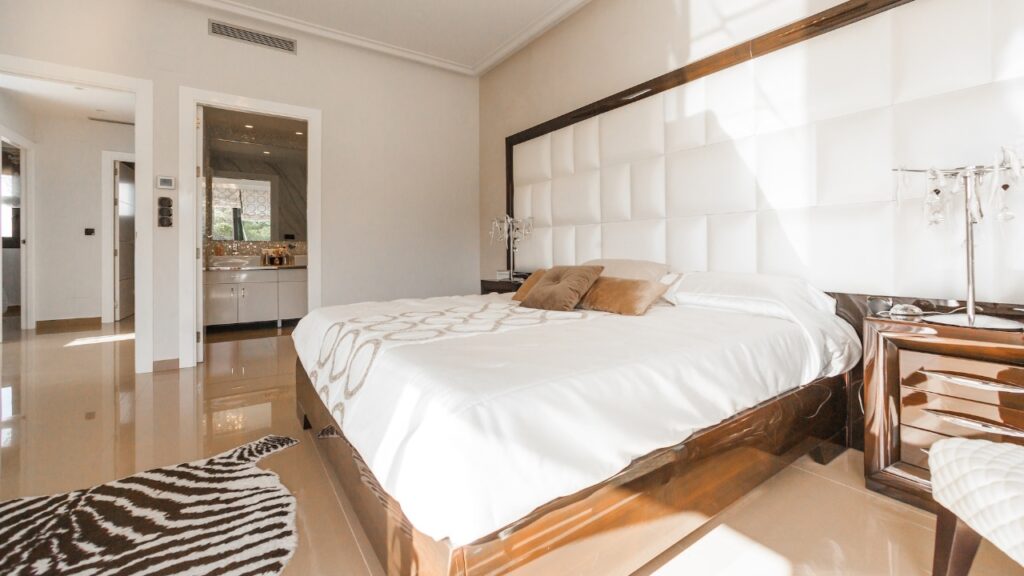Bedspreads and quilts are two popular bedding options, each with its unique characteristics and purposes. Understanding the differences between bedspreads and quilts can help you make the right choice for your bedroom. In this comprehensive guide, we will explore the distinctions between bedspreads and quilts, including their design, construction, functionality, and how to select the best option for your needs.
Bedspreads

A bedspread is a decorative top layer of bedding that covers the entire bed, including the mattress, box spring, and side of the bed. Here are the key characteristics of bedspreads:
Design:
Size: Bedspreads are designed to drape over the entire bed, reaching the floor on all sides. They are available in various sizes to fit different bed dimensions, such as twin, full, queen, and king.
Coverage: Bedspreads cover the mattress and box spring, and they extend over the sides of the bed to create a neat and flowing look. They typically reach the floor, hiding the bed frame and under-bed storage.
Hemming: Bedspreads often have a tailored and finished edge, which can be straight or scalloped, adding to their overall decorative appeal.
Color and Pattern: Bedspreads come in a wide range of colors, patterns, and designs. They are a prominent part of the bedroom decor, and their visual appeal can be a key element of the room’s aesthetics.
Construction:
Material: Bedspreads can be made from various materials, including cotton, polyester, chenille, and blends. The choice of material can affect their texture, weight, and overall comfort.
Fill: Bedspreads are typically lightweight and do not have a fill layer like quilts. They are not designed to provide significant warmth but rather to add a decorative layer to the bed.
Stitching: Bedspreads are often made with decorative stitching or quilting patterns. This stitching adds texture and detail to the fabric, enhancing their aesthetic appeal.
Functionality:
Decorative: Bedspreads are primarily used for decorative purposes. They add a layer of style and elegance to the bed, complementing the bedroom’s decor.
Easy Care: Bedspreads are relatively easy to care for and can be machine-washed and dried, making them a convenient bedding option.
Seasonality: They are suitable for use throughout the year, as their primary function is to enhance the bedroom’s appearance rather than provide warmth.
Quilts:

Quilts, on the other hand, are functional and often more versatile bedding options known for their warmth and craftsmanship. Here are the key characteristics of quilts:
Design:
Size: Quilts come in various sizes, including twin, full, queen, and king. While they can be used as a top layer, they are often used as a layer underneath a decorative bedspread or comforter.
Coverage: Quilts are designed to cover the mattress and box spring, but they do not typically drape to the floor like bedspreads. They provide a neat and tailored look that complements the bed.
Hemming: Quilts often feature straight or scalloped hems, which contribute to their overall appearance.
Color and Pattern: Quilts are available in a wide range of colors and patterns. Many quilts are handmade or have a handcrafted appearance, which adds to their charm.
Construction:
Material: Quilts are usually made from multiple layers of fabric, including a top layer (often cotton or other natural fibers), a middle layer of batting (for warmth), and a backing fabric.
Fill: The batting or fill layer of a quilt is responsible for its warmth. Depending on the type and amount of batting used, quilts can provide varying levels of insulation.
Stitching: Quilts are known for their intricate stitching patterns. The top layer, batting, and backing are sewn together in a decorative and functional manner, often using a technique called quilting.
Functionality:
Warmth: Quilts are designed to provide warmth and insulation, making them a practical choice for colder seasons. The thickness and type of batting used in a quilt influence its warmth.
Layering: Quilts are often used as part of a layered bedding arrangement. They can serve as a middle layer between a decorative bedspread or comforter and a fitted sheet.
Craftsmanship: Many quilts are handcrafted and showcase the artistry and skill of the maker. This craftsmanship can make quilts cherished heirlooms.
Seasonality: Quilts are versatile and can be used year-round. They provide warmth in the winter and can be used on their own or as an additional layer in the summer.
Selecting the Right Bedding Option
When deciding between a bedspread and a quilt, consider the following factors:
Aesthetics: If you prioritize the visual appeal of your bedding and want a decorative top layer, a bedspread may be the better choice. Bedspreads come in a wide range of colors and patterns to enhance your bedroom decor.
Warmth: If you need bedding that provides warmth and insulation, especially in cooler seasons, a quilt is the more suitable option. Quilts are known for their warmth due to their batting layer.
Layering: If you prefer a layered bedding look, you can combine a quilt with a decorative bedspread or comforter. This allows you to enjoy both the decorative elements of a bedspread and the warmth of a quilt.
Seasonality: Consider the climate in your area. Bedspreads are more versatile for year-round use, while quilts are better for colder seasons.
Maintenance: Bedspreads are generally easier to care for as they can be machine-washed and dried. Quilts with intricate stitching may require more delicate care.
Craftsmanship: If you appreciate handcrafted or artisanal bedding, a quilt with intricate stitching and handmade details may be more appealing.
Conclusion
The choice between a bedspread and a quilt largely depends on your aesthetic preferences, the level of warmth you need, and whether you want to enjoy the artistry of handcrafted bedding. Both bedspreads and quilts have their distinct roles in bedroom decor and functionality, and you can even use them together to create a layered, stylish, and cozy bedding arrangement. Ultimately, your choice should reflect your personal style, comfort needs, and the overall design of your bedroom.


